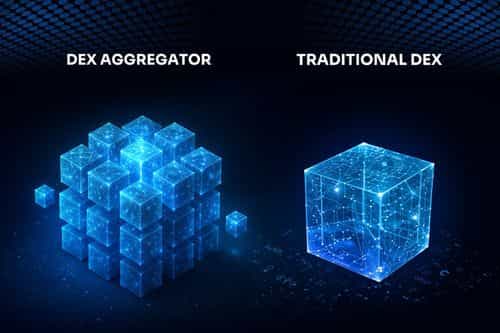The evolution of decentralized exchanges: From early days to modern DEXs


Decentralized exchanges (DEXs) have come a long way from their humble beginnings to becoming a pillar of the cryptocurrency ecosystem. Unlike centralized exchanges (CEXs), DEXs operate without intermediaries, enabling direct peer-to-peer (P2P) transactions while enhancing security and user control. Over the years, these platforms have evolved significantly, addressing early limitations and integrating cutting-edge innovations. This article explores the history, development, and future of DEXs, highlighting key milestones and emerging trends shaping the decentralized trading landscape.
Understanding decentralized exchanges (DEXs): A fundamental overview
A decentralized exchange (DEX) is a platform that facilitates cryptocurrency trading without relying on a central authority. Instead of using traditional order books and third-party custody, DEXs utilize blockchain technology and smart contracts to enable trustless transactions.
Core characteristics of DEXs
The early days of decentralized exchanges: Pioneering platforms
Before modern DEXs became a core part of the crypto ecosystem, early decentralized exchanges struggled to gain traction due to technological limitations, lack of user adoption, and liquidity issues. These early platforms aimed to provide an alternative to centralized exchanges, addressing concerns about trust, security, and censorship resistance. However, they were often complex, slow, and difficult to use, limiting their effectiveness.
The initial generation of DEXs laid the foundation for future innovation by experimenting with on-chain trading mechanisms and decentralized order books. Despite their limitations, they played a crucial role in demonstrating that peer-to-peer crypto trading without intermediaries was possible.
The origins of DEXs: First-generation platforms
The first wave of decentralized exchanges emerged as a response to the vulnerabilities and inefficiencies of centralized trading platforms. Early DEXs were basic, offering limited liquidity and complex user experiences. Some notable first-generation DEXs include:
Challenges faced by early decentralized exchanges
While these early platforms provided innovative solutions, they struggled with several obstacles:
The rise of modern DEXs: Innovations and features
The next generation of DEXs introduced significant improvements, addressing earlier shortcomings through innovative designs and enhanced functionality. Modern DEXs utilize automated market makers (AMMs), layer-2 solutions, and cross-chain interoperability to create a seamless trading experience.
Key features that define today’s decentralized exchanges
The future of decentralized exchanges: Trends and predictions
Decentralized exchanges continue to evolve, shaping the future of digital asset trading. Several trends are likely to define the next phase of DEX development:
Regulatory challenges facing decentralized exchanges
As decentralized exchanges gain traction, they must pass an increasingly complex regulatory landscape. Governments and financial regulators worldwide are working to establish frameworks for decentralized finance (DeFi) platforms, including DEXs.
Some of the key regulatory challenges include:
Opportunities for compliance-friendly DEX models
Despite these challenges, there are also opportunities:
Conclusion
The evolution of decentralized exchanges showcases the rapid innovation within the blockchain ecosystem. From early, inefficient platforms to modern, feature-rich solutions, DEXs have transformed how users trade digital assets. While challenges remain, continuous improvements in scalability, security, and user experience are clearing the path for widespread adoption. As the landscape evolves, DEXs are situated to play an even more significant role in designing long-term financing, presenting an autonomous choice to standard exchanging platforms. The evolution of decentralized markets has been fast, birthing both problems and possibilities in turning. Though challenges stay in attaining workability at scale, everyday betterments demonstrate continuous movement closer to a future where all exchanges are permissionless, trustless, and without intermediaries.
Resources
Frequently asked questions
Check out most commonly asked questions, addressed based on community needs. Can't find what you are looking for?
Contact us, our friendly support helps!
What makes a decentralized exchange (DEX) different from a centralized exchange (CEX)?
A DEX enables peer-to-peer trading without intermediaries, while a CEX acts as a middleman, managing orders and holding users’ funds.
What role does cross-chain compatibility play in modern DEXs?
By connecting multiple blockchains, cross-chain DEXs ensure that users are not limited to a single ecosystem, allowing them to swap assets efficiently across various networks. This reduces fragmentation in the crypto market, activates innovation, and expands the range of trading opportunities for users.
What benefits do DEX aggregators bring to traders?
DEX aggregators, such as Rango, scan multiple DEXs and cross-chain bridges to find the best rates, lowest fees, and optimal trade routes for users. This enhances liquidity, accessibility, and interoperability, enabling a more satisfactory trading experience.




